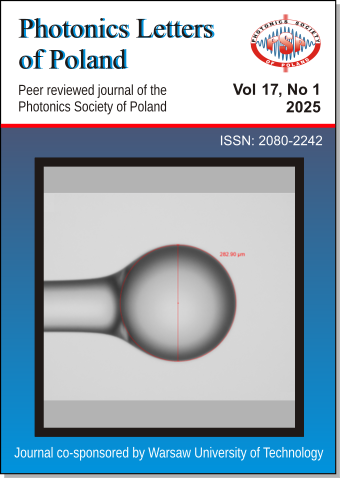Enhanced Sensitivity of Absorption Spectroscopy Glucose Detection by Machine Learning
DOI:
https://doi.org/10.4302/plp.v17i1.1319Abstract
In this study, UV-VIS spectroscopy was used as a tool for detecting low glucose concentrations in urine. Measurements were performed on artificial urine samples and solutions with 0.1% and 0.2% glucose, covering both normal and pathological thresholds. Among the evaluated models, Random Forest reached 0.887 for the 0.1% glucose sample, while Logistic Regression achieved 0.7796 for the 0.2% glucose sample, demonstrating high effectiveness in distinguishing glucose levels. The results confirm that the integration of UV-VIS spectroscopy and machine learning has the potential to serve as a fast and non-invasive screening tool for the early detection of metabolic disorders.
Full Text: PDF
References
- S. L. Cowart and M. E. Stachura, Clinical Methods: The History, Physical, and Laboratory Examinations, 3rd edition, chapter 139, 1990. DirectLink
- P. Sokołowski, P. Wityk, K. Cierpiak, M. Babińska, W. Graczyk, B. Krawczyk, M. Markuszewski and M. Szczerska, "Optical method supported by machine learning for urinary tract infections discrimination and bladder cancer detection", Optical Sensing and Detection VIII, Proc. SPIE, 12999, 129992B (2024). CrossRef
- T.-T. Wang, K. Guo, X.-M .Hu, J. Liang, X.-D. Li, Z.-F. Zhang and J. Xie, "Label-Free Colorimetric Detection of Urine Glucose Based on Color Fading Using Smartphone Ambient-Light Sensor", Chemosensors, 8(1) (2020). CrossRef
- P. Sokołowski, K. Cierpiak, M. Szczerska, M. Wróbel, A. Łuczkiewicz, S. Fudala-Księżek and P. Wityk, "Optical method supported by machine learning for dynamics of C-reactive protein concentrations changes detection in biological matrix samples", J. Biophoton., e202300523 (2024). CrossRef
- M. Jędrzejewska-Szczerska, M. Gnyba, M. Sobaszek and E. Krystian, "Spectroscopic wireless sensor of hematocrit level", Sensors and Actuators A: Physical, 202, 8 (2013). CrossRef
- P. Wityk, P. Sokołowski, M. Szczerska, K. Cierpiak, B. Krawczyk and M. J. Markuszewski, " P. Wityk, P. Sokołowksi, M. Szczerska, K. Cierpiak, B. Krawczyk and M. J. Markuszewski, Journal of Biophotonics,16(9), e202300095 (2013).", J. Biophoton.,16(9), e202300095 (2013). CrossRef
- R.T.Yunardi, R. Apsari and M. Yasin, "Comparison of Machine Learning Algorithm For Urine Glucose Level Classification Using Side-Polished Fiber Sensor ", J.Electronic.Electromed.Eng.Med.Inform, 2(2), 33 (2020). CrossRef
- A. Althnian, D. AlSaeed, H. Al-Baity, A. Samha, A.B. Dris, N. Alzakari, A. Abou Elwafa and H. Kurdi, "Impact of Dataset Size on Classification Performance: An Empirical Evaluation in the Medical Domain", Appl. Sci., 11(2), (2021). CrossRef
- S. Walford, M. McB Page and S. P. Allison, "The Influence of Renal Threshold on the Interpretation of Urine Tests for Glucose in Diabetic Patients", Diabetes Care, 3(9), 672 (1980). CrossRef
- Thermo Fisher Scientific, "NanoDrop One Microvolume UV-Vis Spectrophotometers Product Specifications". DirectLink
- A.M.C. Davies and T. Fearn,"Back to basics: the principles of principal component analysis", Spectroscopy Europe/World, (2004). DirectLink
- N. Sancar and S. S. Tabrizi, "Machine learning approach for the detection of vitamin D level: a comparative study", BMC Medical Informatics and Decision Making, 23(219) (2023). CrossRef
- T. Pranckevičius, V. Marcinkevičius, "Comparison of Naïve Bayes, Random Forest, Decision Tree, Support Vector Machines, and Logistic Regression Classifiers for Text Reviews Classification", Baltic J. Modern Computing, 5(2), 221 (2017). CrossRef
- M. Marzejon, M. Kosowska, D. Majchrowicz, B. Buło-Piontecka, M. Wąsowicz and M. Jędrzejewska-Szczerska, "Label-free optical detection of cyclosporine in biological fluids", J. Biophoton., 12(4), e201800273 (2018). CrossRef
- S. Uddin, A. Khan, M. Hossain and M. Ali Moni, "Comparing different supervised machine learning algorithms for disease prediction", BMC Medical Informatics and Decision Making, 19, 281(2019). CrossRef
Downloads
Published
How to Cite
Issue
Section
License
Copyright (c) 2025 Maria Babińska, Adam Władziński

This work is licensed under a Creative Commons Attribution 4.0 International License.
Authors retain copyright and grant the journal right of first publication with the work simultaneously licensed under a Creative Commons Attribution License that allows others to share the work with an acknowledgement of the work's authorship and initial publication in this journal. Authors are able to enter into separate, additional contractual arrangements for the non-exclusive distribution of the journal's published version of the work (e.g., post it to an institutional repository or publish it in a book), with an acknowledgement of its initial publication in this journal. Authors are permitted and encouraged to post their work online (e.g., in institutional repositories or on their website) prior to and during the submission process, as it can lead to productive exchanges, as well as earlier and greater citation of published work (See The Effect of Open Access).




